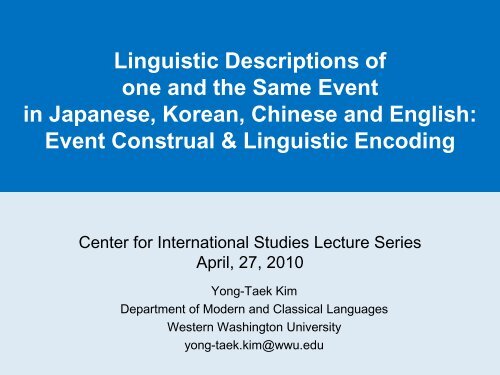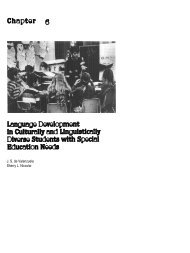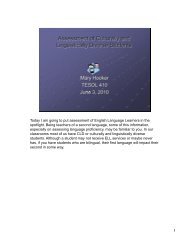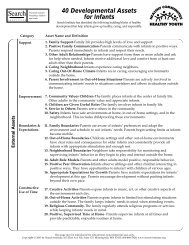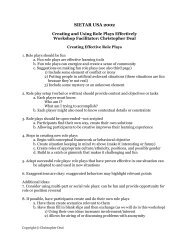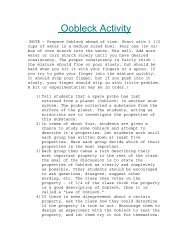Event Construal & Linguistic Encoding
Event Construal & Linguistic Encoding
Event Construal & Linguistic Encoding
- No tags were found...
You also want an ePaper? Increase the reach of your titles
YUMPU automatically turns print PDFs into web optimized ePapers that Google loves.
<strong>Linguistic</strong> Descriptions ofone and the Same <strong>Event</strong>in Japanese, Korean, Chinese and English:<strong>Event</strong> <strong>Construal</strong> & <strong>Linguistic</strong> <strong>Encoding</strong>Center for International Studies Lecture SeriesApril, 27, 2010Yong-Taek KimDepartment of Modern and Classical LanguagesWestern Washington Universityyong-taek.kim@wwu.edu
Contents1. Different descriptions of one and the same scene in J, K, C & E:„He pounded the metal flat.‟2. Psychological Experiment: Perceptional difference of one andthe same scene3. Relation btw How We View vs. How We Describe a scene.4. Simplified Extended Semantic Map model (Kim, Y. 2009)5. Core part of my dissertation:(X) He was carving at the turkey. How come?(O)He was carving away at the turkey. (Jackendoff 1997)6. <strong>Linguistic</strong> description of a scene reflects not the external worldbut a speaker‟s construal of the worldCf. <strong>Construal</strong> is a social psychological term that refers to the wayin which people perceive, comprehend, and interpret the worldaround them.(from Wikipedia)Y. Kim, <strong>Event</strong> <strong>Construal</strong> and Its <strong>Linguistic</strong> <strong>Encoding</strong> 2/24
Two Goals of PresentationY. Kim, <strong>Event</strong> <strong>Construal</strong> and Its <strong>Linguistic</strong> <strong>Encoding</strong> 3/24I. User-friendly linguistic model to predict what typesof verbs can or cannot occur in a given constructionInteraction between carve (away) and the verb-at(1a) Simmy was carving at the roast. (X)(1b) Simmy was carving away at the roast. (O)II. Apply the model to Second LanguageTeaching/Learning
Y. Kim, <strong>Event</strong> <strong>Construal</strong> and Its <strong>Linguistic</strong> <strong>Encoding</strong> 4/24Different Descriptions of the Same <strong>Event</strong> inEnglish, Chinese, Korean, and Japanese(2E)He pounded the metal flat.(2C) 他 捶 平 了 这 块 金 属he hit flat Perf this classifier metal(2K) (?)그가 철판을 [납작하게 두들겼다](2J) ?? 彼 が 鉄 板 を [ぺちゃんこに 叩 いた]he metal flat pounded(3K) 납작하게 될-때까지 두들겼다(3J) ぺちゃんこに なる-まで 叩 いたflat become-until pounded(4K)(4J)[He pounded the metal]<strong>Event</strong> CAUSE [The metal became flat]Change두들겨(서)-폈다叩 [いて/き]- 伸 ばしたpound-spreadCHANGE
Holistic vs. Analytic PerceptionY. Kim, <strong>Event</strong> <strong>Construal</strong> and Its <strong>Linguistic</strong> <strong>Encoding</strong> 5/24Nisbett (2003), Nisbett and Masuda (2003)TaskAsianWesterner(from Kishimoto 2007)
Y. Kim, <strong>Event</strong> <strong>Construal</strong> and Its <strong>Linguistic</strong> <strong>Encoding</strong> 6/24Holistic vs. Analytic Perception in J & E• Participants vs. Setting (Kishimoto 2007)EnglishJapanese5E. Where am I ?6E. He came to me.5J. ここは どこですか。lit. Here is where?6Ja. 彼 は 私 に 来 た。(X)He to me cameCf. Korean (o)6Jb. 彼 は 私 のところに 来 た。(O)He to my place came7E. I studied Japanese here yesterday.7J. 昨 日 、 ここで 日 本 語 を 勉 強 しました。yesterday here Japanese studied
How We View vs. How We DescribeLet‟s imagine a scene:James moved his hand toward the knob, opened the door, and itis open now.Vt Vi ViHe opened the door. vs. The door opened. vs. The door is open.(activity + change) (change) (state)Typical transitive event• <strong>Linguistic</strong> description; not realities in the world,but a speaker’s construal of the worldY. Kim, <strong>Event</strong> <strong>Construal</strong> and Its <strong>Linguistic</strong> <strong>Encoding</strong> 7/24
Starting Point of My DissertationY. Kim, <strong>Event</strong> <strong>Construal</strong> and Its <strong>Linguistic</strong> <strong>Encoding</strong> 9/24Jackendoff, Ray. 1997. Twistin’ the night away, Language 73:534-559“Some verbs such as carve are happy in the‘Verb + at’ construction only if away is present”(1a) Simmy was carving at the roast. (X)(1b) Simmy was carving away at the roast. (O)Just MEMORIZE!Any idea?
Yes!!!Y. Kim, <strong>Event</strong> <strong>Construal</strong> and Its <strong>Linguistic</strong> <strong>Encoding</strong> 10/24
Research Questions1. What verb types can and cannot occur in the V-atconstruction?2. Motivation for interrelation between Perception,Cognitive <strong>Construal</strong> & <strong>Linguistic</strong> Representation11Y. Kim, <strong>Event</strong> <strong>Construal</strong> and Its <strong>Linguistic</strong> <strong>Encoding</strong> 11/24
12Y. Kim, <strong>Event</strong> <strong>Construal</strong> and Its <strong>Linguistic</strong> <strong>Encoding</strong> 12/24Perception, Cognition & Representation• Kim, Y. (2009)Perception[External World]Cognitive <strong>Construal</strong>[Cognitive World]<strong>Linguistic</strong> Representation[Language]Situation <strong>Event</strong> structure: SentencesA boy swung a batseveral times, finallyhit a vase, andthe vase broke.Agent [Activity]Agent-LOC [Activity]Agent-Theme [Change]Theme [State]He swung (several times).He hit the vase.He broke the vase.The vase is broken.Cf. LOC vs. Theme ≈ Non-change of State vs. Change of State8a. I don‟t want to buy it because it was hit.8b. I don‟t want to buy it because it was broken.(X) Non-change of state(O) Change of state
Extended Semantic Map modelKim, Y. (2008a, 2008b, 2009): How to visualize constructionsSituation = Participants [SPACE] + Relations among them [TIME]ESM = Construction Grammar + Cognitive Attentional system1. Construction Grammar (Goldberg 1995, Croft 2001)i) Definition of Construction:Any grammatical structure, indicating form & meaningii) Independent Constructional meaning(9) He hit out with that stick.Q: Where does the meaning of „wild and uncontrolled activity‟ comefrom? From hit or out?(10) This is a potential time bomb ticking away at the fabric ofsociety. (British National Corpus)Q: How can tick be used in a 2 participant event?(11)ドアが 開 けてある。‟The door has been opened (by someone).‟Q: Where does the beneficial meaning come from?Y. Kim, <strong>Event</strong> <strong>Construal</strong> and Its <strong>Linguistic</strong> <strong>Encoding</strong> 13/24
Y. Kim, <strong>Event</strong> <strong>Construal</strong> and Its <strong>Linguistic</strong> <strong>Encoding</strong> 14/24Constructional Meanings• X Verb-At Y:„X directs force at Y volitionally while defocusing Y‟s change.‟(12) He hit at the crazy dog.• X Verb-Away-At Y:„X directs force at Y persistently while defocusing Y‟s change.‟(13) He hit away at the crazy dog.• X Verb-Away:„X is engaged in an activity continuously without a focused Y.‟(14) He hammered away.
Cognitive Attentional System- Talmy‟s attentional system (Talmy 2000):focus of attention & windowing of attention1. focus of attention on participants: perceptual prominenceAgent, Agent-Loc, Agent-Theme, ThemeY-axis2. windowing of attention on relations: cognitive prominenceVolition, Activity, Force (or Energy) Transfer, Change, StateTypical two participant event is either Activity or Change-windowing.X-axis15Y. Kim, <strong>Event</strong> <strong>Construal</strong> and Its <strong>Linguistic</strong> <strong>Encoding</strong> 15/24
AGENTFOCUS OF ATTENTIONAGENT-LOCAGENT-THEMETHEMEAGENT AGENT AGENT LOC THEME THEMEVOLITIONACTIVITYFORCETRANSFERCHANGEWINDOWING OF ATTENTIONSTATEY. Kim, <strong>Event</strong> <strong>Construal</strong> and Its <strong>Linguistic</strong> <strong>Encoding</strong> 16/24
Y. Kim, <strong>Event</strong> <strong>Construal</strong> and Its <strong>Linguistic</strong> <strong>Encoding</strong> 17/24<strong>Encoding</strong> of <strong>Event</strong>sSceneControllerUndergoerControllerUndergoerControllerUndergoerPerception Cognitive <strong>Construal</strong> RepresentationFocus ofattentionPrimaryØPrimarySecondaryWindowingof attentionActivityActivity + F.T.F. T. + ChangeSemanticsAgentAgent-LOCAgent-ThemeØPrimary State ThemeSyntaxintransitive(He swung.)transitive(He hit it.)(He broke it.)intransitive(It is broken.)
Y. Kim, <strong>Event</strong> <strong>Construal</strong> and Its <strong>Linguistic</strong> <strong>Encoding</strong> 18/24AGENTHe swungAGENT-LOCHe hit itAGENT-THEMEHe broke itTHEMEIt brokeIt is brokenAGENT AGENT AGENT LOC THEME THEMEVOLITIONACTIVITYFORCETRANSFERCHANGESTATE
DataV-At V-Away-At V-AwayTypes 59 68 33Tokens 1241 148 124(from British National Corpus)19Y. Kim, <strong>Event</strong> <strong>Construal</strong> and Its <strong>Linguistic</strong> <strong>Encoding</strong> 19/24
Methodology20Y. Kim, <strong>Event</strong> <strong>Construal</strong> and Its <strong>Linguistic</strong> <strong>Encoding</strong> 20/24ManneradverbialsImperfectiveaspectPassiveconstruction[Activity]-windowingmoremoreless[Change]-windowinglesslessmore
Y. Kim, <strong>Event</strong> <strong>Construal</strong> and Its <strong>Linguistic</strong> <strong>Encoding</strong> 21/24AGENTX Verb-Away.AGENT-LOCX Verb-At Y.X Verb-Away-At Y.AGENT-THEMETHEMEAGENT AGENT AGENT LOC THEME THEMEVOLITIONACTIVITYFORCETRANSFERCHANGESTATE
Y. Kim, <strong>Event</strong> <strong>Construal</strong> and Its <strong>Linguistic</strong> <strong>Encoding</strong> 22/24AGENTX Verb-Away.(1a) * Simmy was carving at the roast.(1b) Simmy was carving away at the roast.carve awayAGENT-LOCX Verb-At Y.X Verb-Away-At Y.AGENT-THEMEcarveTHEMEAGENT AGENT AGENT LOC THEME THEMEVOLITIONACTIVITYFORCETRANSFERCHANGESTATE
Y. Kim, <strong>Event</strong> <strong>Construal</strong> and Its <strong>Linguistic</strong> <strong>Encoding</strong> 23/24AGENTAGENT-LOCHe pounded the metal他 捶 了 这 块 金 属그가 칠판을 두들겼다彼 が 鉄 板 を 叩 いたHe pounded the metal flat他 捶 平 了 这 块 金 属AGENT-THEME(?)그가 철판을 납작하게 두들겼다납작하게 될-때까지ぺちゃんこになる-までbecome flat-until폈다伸 ばしたspreadedThe metal became flatTHEME这 块 金 属 变 平 了철판이 납작해졌다鉄 板 がぺちゃんこになったAGENT AGENT AGENT LOC THEME THEMEVOLITIONACTIVITYFORCETRANSFERCHANGESTATE
Y. Kim, <strong>Event</strong> <strong>Construal</strong> and Its <strong>Linguistic</strong> <strong>Encoding</strong> 24/24Conclusion• An Extended Semantic Map Model:- Relations between verb, verb-at , verb-away-atconstruction- Possible verbs in any construction[Activity]- vs. [Change]-windowing• Motivation for the Interrelation between Perception,Cognitive construal and linguistic encoding• Possibility of comparative analysis acrosslanguages• Application of an Extended Semantic Map modelto Second Language Teaching/Learning
THANKS A LOT FOR YOURATTENTION
BibliographyCroft, William. 2001. Radical Construction Grammar: Syntactic Theory in Typological Perspective, Oxford: Oxford University Press.Goldberg, Adele. 1995. Constructions: A Construction Grammar Approach to Argument Structure.Chicago: University of Chicago Press.Jackendoff, Ray. 1997. Twistin’ the night away. Language 73: 534-59.Kim, Yong-Taek. 2008a. Relations between the Conative and Verb-Out At Constructions: AnExtended Semantic Map Approach, paper presented at the 34 th Annual Meeting of the Berkeley<strong>Linguistic</strong>s Society.Kim, Yong-Taek. 2008b. Conative and Its Related Constructions: An Extended Semantic MapApproach, paper presented at the 5th ICCG (International Conference on Construction Grammar),Austin, University of Texas.Kim, Yong-Taek. 2009. <strong>Event</strong> <strong>Construal</strong> and Its <strong>Linguistic</strong> <strong>Encoding</strong>: Towards an Extended SemanticMap Model. Ph.D. dissertation. University of Oregon.Kishimoto, Kyoko. 2007. A Cognitive Study of Subjective <strong>Construal</strong> in Possessive Phenomena, M.A.thesis, Kanazawa University.Nisbett, R.E. (2003) The Geography of Thought: How Asians and Westerners Think Differently andWhy, The Free Press.Nisbett, R.E. and Masuda, T. (2003) Culture and point of view. Proc. Natl. Acad. Sci. U. S. A. 100,11163–11175.Talmy, Leonard. 2000. Toward a Cognitive Semantics, Volume 1: Concept Structuring Systems.Cambridge, MA: MIT Press.
AdvertisementSummer Classes• Intensive Japanese(3hrs/day, 9 weeks)• Introductory Korean(2 hrs/day, 4 weeks)Registration starts on May 4th


